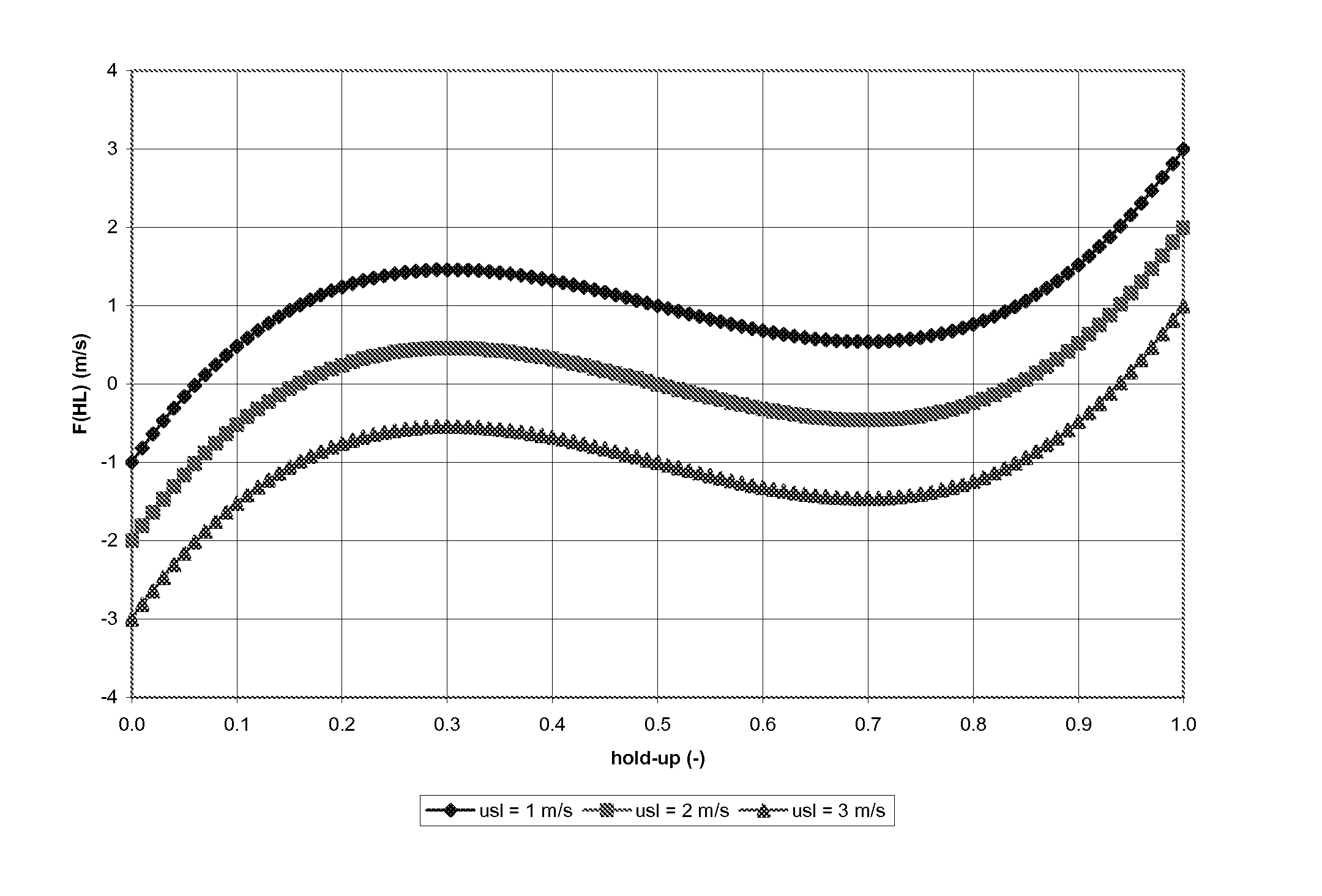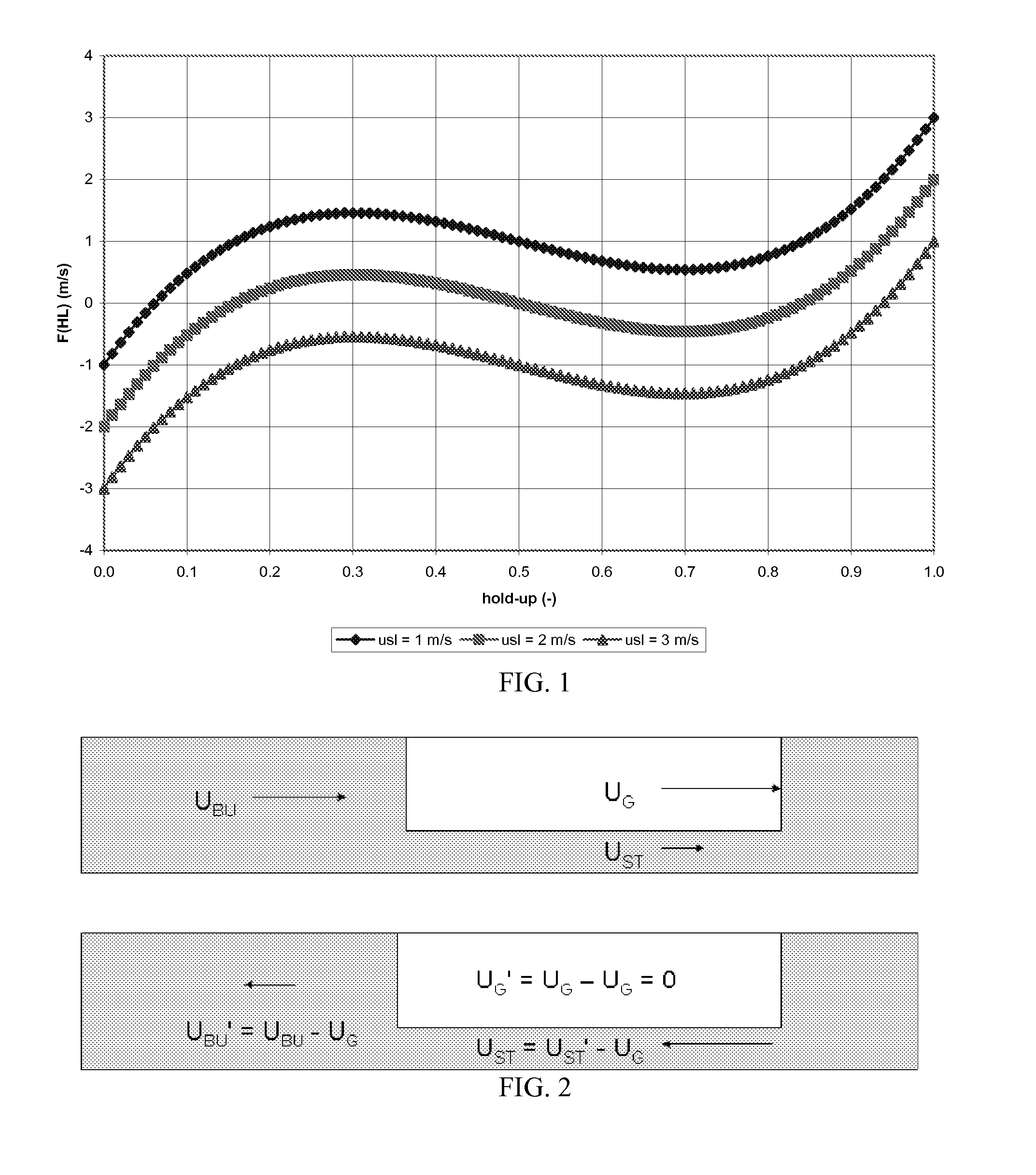Hydrodynamic slug flow model
a flow model and hydrodynamic technology, applied in the field of hydrodynamic slug flow model, can solve the problems of unavoidable oil and gas production, unstable operation, and disappointment, and achieve the effect of minimal effort and good fit to field data
- Summary
- Abstract
- Description
- Claims
- Application Information
AI Technical Summary
Benefits of technology
Problems solved by technology
Method used
Image
Examples
example 1
Stability Analysis
[0130]The stability of these ‘steady-state’ solutions can be examined through the application of mass conservation for a particular point in the pipeline. The mass conservation equation for the liquid phase is given by:
d(ρL δz·A·HL) / dt=(ρL·A·USL)IN−(ρL·A·USL)OUT
If the liquid density, pipe cross-sectional area, and section length are constant, this simplifies to a volume conservation equation:
δz·d(HL) / dt=(USL)IN−(USL)OUT
Consider a single cell, with a constant inlet superficial velocity (USL)IN, with (USL)OUT as a function of the hold-up in that cell:
USL(HL)≡US(HL)HL2+(UM−US(HL))HL
Note that the hold-up equation is used not to determine the hold-up from the superficial velocities and the slip velocity; now the superficial velocity is determined from the hold-up, the slip velocity, and the mixture velocity. The volume conservation equation can be written as:
δz·d(HL) / dt=USL−[hd S(HL)HL2+(UM−US(HL))HL]=−F(HL)
Let HL* be a zero of F(HL) and therefore a solution to the h...
example 2
Multiple Solutions
[0131]Of course, it is entirely possible that the hold-up function F(HL) can cross the hold-up axis at more than one point, i.e., F(HL) can have more than 1 physically-realizable solution. In fact, if F(HL) is a continuous function of HL, any odd solutions is at least topologically possible (even numbers of crossings are not possible if USL, USG>0).
[0132]If the slip velocity US is constant, then F(HL) is quadratic in hold-up. Since a quadratic equation can only have, at most—2 real roots, there can only be a single crossing between 0LL=0)L=1)>0.
[0133]Hydrodynamic slug flow is characterized by high-hold-up slugs of liquid with little slip between the gas and liquid phases separated by low-hold-up stratified regions characterized by high slip between the phases. The gas bubble in the separated region travels at a characteristic speed UG which can be related to mixture velocity via a ‘drift-flux’ relation:
UG=CO·UM+UO
The slip velocity is given by:
US=(UG−UM) / HL=[(CO−1)...
example 3
Change of Reference Frame
[0142]Although the cubic form of F(HL) has many appealing properties, there is one last step that must be addressed in order to formulate our transient slug model. While it is true that the superficial velocities in slug flow are not all equal in a reference frame that is fixed with the pipe, in a moving reference frame they can—in fact—be made to be equal. Consider FIG. 2, which shows slug flow in a fixed frame, and also from a reference frame which moves at the velocity of the gas bubble in the stratified region, UG. The linear velocities in the new reference frame are:
UBU′=UBU−UG; UST′=UST−UG
Obviously, the hold-ups are not a function of reference frame; however, the superficial velocities are. This can be seen by the following:
USBU′ / HB=USBU / HB−UG→USBU′=USBU−UG·HB; USST′ / HS=USST / HS−UG→USST′=USST−UG·HS
Finally, as a consequence of the above:
UM′=UM−UG
In the moving reference frame, USBU′=USST′=UM′, by definition. The gas velocity UG can be calculated from a...
PUM
 Login to View More
Login to View More Abstract
Description
Claims
Application Information
 Login to View More
Login to View More - R&D
- Intellectual Property
- Life Sciences
- Materials
- Tech Scout
- Unparalleled Data Quality
- Higher Quality Content
- 60% Fewer Hallucinations
Browse by: Latest US Patents, China's latest patents, Technical Efficacy Thesaurus, Application Domain, Technology Topic, Popular Technical Reports.
© 2025 PatSnap. All rights reserved.Legal|Privacy policy|Modern Slavery Act Transparency Statement|Sitemap|About US| Contact US: help@patsnap.com



